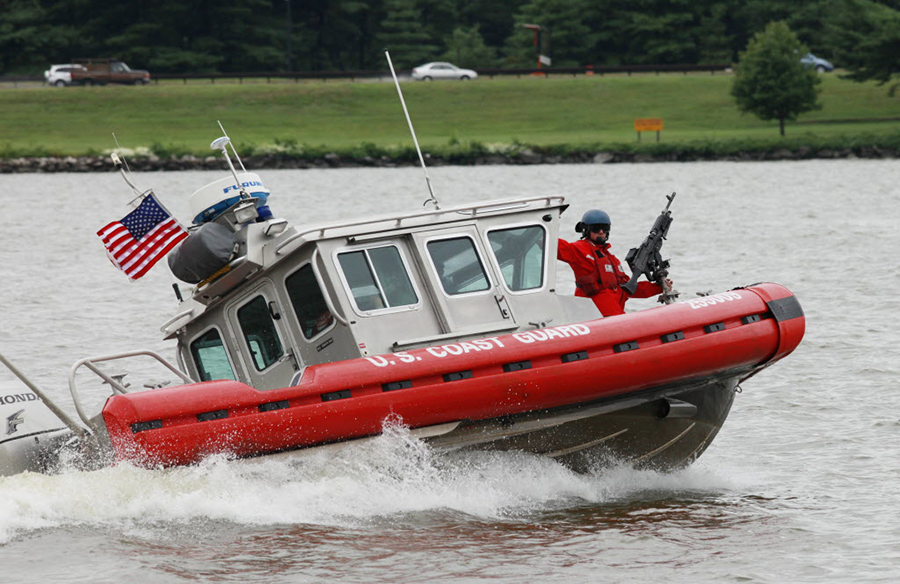Could filing a float plan have helped Potomac boaters?
Loading...
As search teams continue to look for one of the two missing boater whose small vessel was found running unattended in the Potomac River Wednesday night, the value of using the US Coast Guard’s new Safe Boating app to file a float plan for even short trips becomes more apparent.
According to USCG Sector Baltimore Public Affairs Officer David Marin, employees at the Landmark Yacht Club in Stafford County, Virginia, reported Charles Zinter and Melissa Smarr missing at about 11 p.m. Wednesday night. Maryland Natural Resources Police say recovery teams found the body of 58-year-old Charles Zintner Thursday afternoon but Smarr is still missing.
The boaters were scheduled to return to the yacht club at about 5 p.m. Wednesday, Marin says in an interview.
A crew aboard a Maryland State Police helicopter spotted the couple's 19-foot boat anchored and running about one mile from the yacht club. Crews found a cellphone, a woman's handbag, and an open bottle of water on the boat, but the couple was nowhere to be found, a spokesman for the Charles County Fire Department said Thursday.
While someone at the yacht club had a general idea of when the boaters were due back, the pair may not have followed suggested protocol and filed a float plan.
Mr. Marin says, “We don’t have a report of anyone knowing exactly when they left, or exactly when they were expected back.”
A float plan details the planned route with ETA, describes the boat, gives a passenger list, and a checklist of what safety gear, food, and water are aboard. It also alerts rescuers to any potential passenger medical conditions. These details assist the Coast Guard in risk assessment and location of a boater in trouble.
The plan is not filed with the Coast Guard, but given to trusted friends, marina personnel, or relatives who then have all the information necessary to help the USCG and other agencies locate those in danger should the situation arise.
“There was no storm in the area. It’s been pretty clear weather,” he adds. “Without speculating, what we saw is signs that there were people aboard who left the boat, whether meaning to do so temporarily, or it was some sort of accident where they went into the water, the boat was left in a state in which it wouldn’t have been left if they had meant to get off the boat. It was anchored. Whether they went into the water for a swim, whether they fell into the water or they just went aboard a different vessel and didn’t return, we’re trying to figure out which of the scenarios that is.”
Candy Thompson, spokesperson for the Maryland Department of Natural Resource Management Police, which is leading the search, says in an interview, “Nobody here’s seen a float plan. The yacht club called it in so clearly, somebody knew when they were due back but that’s all we have to go on.”
“Last year we had a whole campaign where we begged people to file a float plan,” Ms. Thompson adds, “People just don’t get it. They think ‘Oh I’m just going where I always go,’ or ‘We’re just going for a little while.’ They don’t realize that filing that float plan means peace of mind.”
Getting a float plan and running a checklist of safety items and procedures was made easier with the recent release of a free USCG app.
The app, released during Safe Boating Week (May 16-22), is particularly geared to help take the "search" out of search and rescue.
“Filing a float plan shortens the search time because all the agencies involved know where you planned to be and when,” Marin says. “So even if you deviate off course you’re still giving us a starting point and a point where you will be next.”
In this case, the search is being led by the Maryland Department of Natural Resource Management. Police with USCG, Maryland State Police, and both the Stafford and Charles County Sheriffs’ Departments, according to Marin.
The app also allows boaters to find the latest safety regulations, request a vessel safety check, check safety equipment, learn navigation rules, find the nearest National Oceanic and Atmospheric Administration buoy, and request emergency assistance which is aided by the user’s phone GPS tracking system, much like an emergency position-indicating radio beacon.
The app is available in iOS in the iTunes and for Android via the Google Play Store as a free download.








